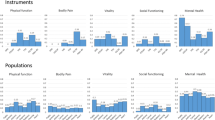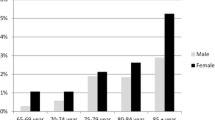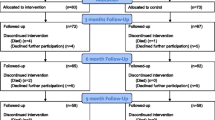Abstract
The Health Utilities Index is a generic multiattribute preference-based system for assessing health-related quality of life, devised by Torrance et al. It is being used in cost-effectiveness evaluations in North America and in international multicentre studies but was not available in France. Following adaptation of the HUI3 classification in France, the purpose of the reported investigation was to derive French preference weights. This article provides a reminder of the theoretical foundations used to model the multiattribute utility function. Within this framework, a multiattribute multiplicative aggregate utility function was constructed in accordance with the explicitly decomposed approach. The study took place in June 1999 over a sample of 365 persons from the French general population, aged between 20 and 65, and not suffering from any chronic or incapacitating illness. The recruitment procedure was based upon a random selection of individuals, using the phone book. Interviews took place in the homes of the interviewees. The methods of revelation (VAS and SG) were applied by setting the value of the best possible state of the HUI3 a priori at 1, and leaving a choice between two states (worst possible state, death) for 0. The aggregated individuals (person-mean and median) were calculated and the multiplicative utility functions constructed. A comparison of the calculated utilities with the observed ones provides a primary indicator of the validity of the person-mean or median functions constructed. The slight absolute differences obtained between observed and calculated utilities and the low RMSE scores lead us towards a favourable conclusion.
Similar content being viewed by others
References
G. Ardine deWits, J. Busschbach and F. de Charro, Sensitivity and perspective in the valuation of health status: whose values count? Health Economics 9 (2000) 109-126.
J. Brazier and M. Deverill, A checklist for judging preference-based measures of health related quality of life: Learning from psychometrics, Health Economics 8 (1999) 41-51.
C. Buron, Utilité et préférences en univers certain et en univers risqué: une application de la théorie de l'utilité multiattribut en économie de la santé Thèse de doctorat en Science Economique, Université Panthéon-Assas (Paris II), soutenue le 18 janvier 1999.
W.B. Carter, R.A. Bobitt, M. Bergner and B.S. Gibson, Validation of interval scaling: The sickness impact profile, Health Services Research 11(4) (1976) 516-528.
N. Costet, C. Le Galès, C. Buron, K. Kinkor, M. Mesbah, J. Chwalow, the clinical and economic working groups and G. Slama, French crosscultural adaptation of the Health Utilities Indexes Mark 2 (HUI2) and 3 (HUI3) classification systems, Quality of Life Research 7(3) (1998) 245-256.
P. Dolan, Modelling valuations for EuroQol health states, Medical Care 35(11) (1997) 1095-1108.
P. Dolan, Aggregating health states valuations, Journal of Health Services Research 2(3) (1997) 160-165.
P. Dolan, C. Gudex, P. Kind and A. Williams, A social tariff for EuroQol: Results from a UK general population survey, Discussion Paper 138, Center for Health Economics, University of York, York (1975).
J.S. Dyer, W. Farrell and P. Bradley, Utility functions for test performance, Management Sciences 20 (1973) 507-519.
J.S. Dyer and R.A. Sarin, Measurable multiattribute value functions, Operations Research 24 (1979) 220-243.
J.S. Dyer and R.A. Sarin, Relative risk aversion, Management Sciences 28(8) (1982) 875-886.
L. Eeckhoudt, Expected utility theory — Is it normative or simply “practical”? Medical Decision Making 16(1) (1996) 12-13.
M.L. Essink-Bot, M.E. Stoudhard and G.J. Bonsel, Generalizability of valuations on health states collected with the EuroQol questionnaire, Health Economics 2 (1993) 237-246.
P.H. Farquhar, A survey of multi-attribute utility theory and application, TIMS Studies in the Management Sciences 6 (1977) 59-89.
G.W. Fischer, Utility models for multiple objective decisions: Do they accurately represent human preferences? Decision Sciences 10(3) (1979) 451-479.
P.C. Fishburn, Independence in utility theory with whole product sets, Operations Research 13 (1965) 28-45.
P.C. Fishburn and G. Kochenberger, Two-piece Von Neumann— Morgenstern utility functions, Decision Sciences 10 (1979) 503-518.
W. Furlong, D. Feeny, G.W. Torrance, C.H. Goldsmith, S. DePauw, Z. Zhu and M. Boyle, Multiplicative multi-attribute utility function for the Health Utilities Index Mark 3 (HUI3) System: A technical report, Working paper series no98-11, CHEPA, McMaster University, Hamilton (1998).
M.R. Gold, J.E. Siegel, L.B. Russel and M.C. Weinstein, eds., Cost-Effectiveness in Health and Medicine (Oxford University Press, New York, 1996).
J.C. Harsanyi, Cardinal utility in welfare economics and in the theory of risk taking, Journal of Political Economy 61 (1953) 434-435.
J.C. Harsanyi, Cardinal welfare, individual ethics and interpersonal comparison of utility, Journal of Political Economy 63 (1955) 309-321.
Health Utilities Group (2000): http://www-fhs.mcmaster.ca/hug/index. htm.
J.A. Johnson, S.J. Coons, A. Ergo and G. Szava-Kovats, Valuation of EuroQol (EQ-5D) health states in an Adult US sample, PharmacoEconomics 13(4) (1998) 421-433.
R.M. Kaplan, J.W. Bush and C.C. Berry, The reliability, stability and generalisability of a health status index, Social Statistics Section. American Statistical Association Proceedings (1978) 704-709.
R.L. Keeney, Utility independence and preferences for multiattributed consequences, Operations Research 19 (1971) 875-893.
R.L. Keeney, Multiplicative utility functions, Operations Research 22 (1974) 22-34.
R.L. Keeney and H. Raïffa, Decision with Multiple Objectives (Wiley, New York, 1976).
L.R. Keller, An empirical investigation of relative risk aversion, IEEE Transactions on Systems, Man and Cybernetics, SMC 15(4) (1985) 475-482.
C. Le Galès, N. Costet, C. Buron and G. Slama, Développement d'un indicateur d'états de santé pondéré par les préférences, Working paper, CHEAR, INSERM U537, Le Kremlin-Bicêtre (2000).
C. Le Galès, N. Costet, J.C. Gentet, C. Kalifa, D. Frappaz, C. Edan, E. Sariban, D. Plantaz and F. Doz, Cross-cultural adaptation of a health status classification in children with cancer. First results of the French adaptation of the HUI2 and 3, International Journal of Cancer 12 (1999) 112-118.
H.A. Llewellyn-Thomas, H.J. Sutherland et al., Methodological issues in obtaining values for health states, Medical Care 22 (1984) 543-552.
A. Mehrez and A. Gafni, An empirical evaluation of two assessment methods for utility measurement for life years, Socio-Economic Planification Science 21(6) (1987) 371-375.
E. Nord, EuroQol: health-related quality of life measurement. Valuation of health states by the general public in Norway, Health Policy 18 (1991) 25-36.
A.M. O'Connor, N.F. Boyd, P. Warde and Stolbach, Eliciting preferences for alternative drug therapies in oncology: Influence of treatment outcome description, elicitation technique and treatment experience on preferences, Journal of Chronic Diseases 40 (1987) 811-818.
D.L. Patrick and Y. Chiang, eds., Health outcomes methodology: Symposium Proceedings, Medical Care 29(9 Suppl. II) (2000).
D.L. Patrick, H.E. Starks, K.C. Cain, R.F. Uhlmann and R.A. Pearlman, Measuring preferences for health states worse than death, Medical Decision Making 14(1) (1994) 9-18.
J.W. Pratt, Risk aversion in the small and in the large, Econometrica 32 (1964) 122-136.
J.L. Read, R.J. Quinn, D.M. Berwick, H.V. Fineberg and M.C. Weinstein, Preferences for health outcomes. Comparison of assessment methods, Medical Decision Making 4(3) (1984) 315-329.
D.A. Revicki, N.K. Leidy, F. Brennan-Diemer, C. Thompson and A. Togias, Development and preliminary validation of the multiattribute Rhinitis Symptom Utility Index, Quality of Life Research 7(8) (1998) 693-702.
R. Rosser and P. Kind, A scale of valuations of states of illness: Is there a social consensus? International Journal Epidemiology 7(4) (1978) 347-358.
G.W. Torrance, Social preferences for health states: An empirical evaluation of three measurement techniques, Socio-Economic Planification Science 10 (1976) 129-136.
G.W. Torrance, W. Furlong, D. Feeny and M. Boyle, Multiattribute preference function. Health Utility Index, PharmacoEconomics 7(6) (1995) 503-520.
G.W. Torrance, D. Feeny, W. Furlong, R.D. Barr, Y. Zhang and Q. Wang, Multiattribute utility function for a comprehensive health status classification system. Health Utilities Index Mark 2, Medical Care 34(7) (1996) 702-722.
J. Von Neumann and O. Morgenstern, Theory of Games and Economic Behaviour, 2nd edn. (Princeton University Press, Princeton, 1947) (1944, 1st edn.).
A.D. Wolfson, A.J. Sinclair, C. Bombardier and A. Mc Geer, Preference measurements for functional status in stroke patients: Interrater and intertechnique comparaisons, in: Values and Long Term Care, eds. R.L. Kane and R.A. Kane (Lexington Books, Lexington, 1982).
Author information
Authors and Affiliations
Corresponding author
Rights and permissions
About this article
Cite this article
Le Galès, C., Buron, C., Costet, N. et al. Development of a Preference-Weighted Health Status Classification System in France: The Health Utilities Index 3. Health Care Management Science 5, 41–51 (2002). https://doi.org/10.1023/A:1013201102918
Issue Date:
DOI: https://doi.org/10.1023/A:1013201102918




